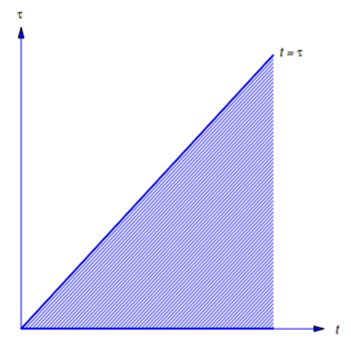8.6: Convolution
( \newcommand{\kernel}{\mathrm{null}\,}\)
In this section we consider the problem of finding the inverse Laplace transform of a product
Taking Laplace transforms yields
so
where
Until now wen’t been interested in the factorization indicated in Equation
To motivate the formula for
which we first solve without using the Laplace transform. The solution of the differential equation in Equation
Integrating this from
Therefore
Now we’ll use the Laplace transform to solve Equation
so
which implies that
If we now let
then Equation
and
respectively. Therefore
in this case.
This motivates the next definition.
The convolution
It can be shown (Exercise 8.6.6) that
Equation
If
A complete proof of the convolution theorem is beyond the scope of this book. However, we’ll assume that
This iterated integral equals a double integral over the region shown in Figure 8.6.1 . Reversing the order of integration yields
However, the substitution
Substituting this into Equation

Let
Verify that
Solution
We first compute
Since
it follows that
A Formula for the Solution of an Initial Value Problem
The convolution theorem provides a formula for the solution of an initial value problem for a linear constant coefficient second order equation with an unspecified. The next three examples illustrate this.
Find a formula for the solution of the initial value problem
Solution
Taking Laplace transforms in Equation
Therefore
From the table of Laplace transforms,
Since
the convolution theorem implies that
Therefore the solution of Equation
Find a formula for the solution of the initial value problem
Solution
Taking Laplace transforms in Equation
Therefore
From the table of Laplace transforms,
Since
the convolution theorem implies that
Therefore the solution of Equation
Find a formula for the solution of the initial value problem
Solution
Taking Laplace transforms in Equation
Therefore
From the table of Laplace transforms,
Since
the convolution theorem implies that
Therefore the solution of Equation
Evaluating Convolution Integrals
We’ll say that an integral of the form
Evaluate the convolution integral
Solution
We could evaluate this integral by expanding
the convolution theorem implies that
where we have written the second equality because
Hence,
Use the convolution theorem and a partial fraction expansion to evaluate the convolution integral
Solution
Since
the convolution theorem implies that
Expanding this in a partial fraction expansion yields
Therefore
Volterra Integral Equations
An equation of the form
is a Volterra integral equation. Here
and solving this for
We then obtain the solution of Equation
Solve the integral equation
Solution
Taking Laplace transforms in Equation
and solving this for
Hence,
Transfer Functions
The next theorem presents a formula for the solution of the general initial value problem
where we assume for simplicity that
Suppose
is
where
and
and
- Proof
-
Taking Laplace transforms in Equation
where
Hence,
with
and
Taking Laplace transforms in Equation
Therefore
and
Hence, Equation
Substituting this into Equation
Taking inverse transforms and invoking the convolution theorem yields Equation
It is useful to note from Equation
where
depends on the initial conditions and is independent of the forcing function, while
depends on the forcing function and is independent of the initial conditions. If the zeros of the characteristic polynomial
of the complementary equation have negative real parts, then
are
is the transient component of the solution and
is the steady state component. The definitions don’t apply to the initial value problems considered in Examples 8.6.2 and 8.6.3 , since the zeros of the characteristic polynomials in these two examples don’t have negative real parts.
In physical applications where the input
we see that
is the ratio of the transform of the steady state output to the transform of the input.
Because of the form of
Formula Equation


